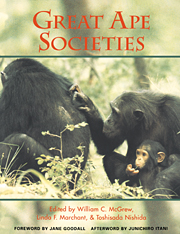Book contents
- Frontmatter
- Contents
- List of contributors
- Preface
- Foreword: conserving great apes
- Part I Apes overviewed
- Part II Social ecology
- 4 Social ecology of Kanyawara chimpanzees: implications for understanding the costs of great ape groups
- 5 Ranging and social structure of lowland gorillas in the Lopé Reserve, Gabon
- 6 Sympatric chimpanzees and gorillas in the Ndoki Forest, Congo
- 7 Dietary and ranging overlap in sympatric gorillas and chimpanzees in Kahuzi-Biega National Park, Zaïre
- Part III Social relations
- Part IV Minds
- Part V Apes compared
- Part VI Modeling ourselves
- Afterword: a new milestone in great ape research
- Appendix: great ape study sites
- Index
5 - Ranging and social structure of lowland gorillas in the Lopé Reserve, Gabon
Published online by Cambridge University Press: 04 August 2010
- Frontmatter
- Contents
- List of contributors
- Preface
- Foreword: conserving great apes
- Part I Apes overviewed
- Part II Social ecology
- 4 Social ecology of Kanyawara chimpanzees: implications for understanding the costs of great ape groups
- 5 Ranging and social structure of lowland gorillas in the Lopé Reserve, Gabon
- 6 Sympatric chimpanzees and gorillas in the Ndoki Forest, Congo
- 7 Dietary and ranging overlap in sympatric gorillas and chimpanzees in Kahuzi-Biega National Park, Zaïre
- Part III Social relations
- Part IV Minds
- Part V Apes compared
- Part VI Modeling ourselves
- Afterword: a new milestone in great ape research
- Appendix: great ape study sites
- Index
Summary
INTRODUCTION
At the time of the first Wenner-Gren conference on ‘The Great Apes’ in 1974, western lowland gorillas had been little studied in the wild. Apart from the pioneering field study of Jones & Sabater Pi (1971), knowledge of gorilla ecology in central west Africa came from the anecdotes of explorers and big game hunters. Jones & Sabater Pi, working in Equatorial Guinea (Rio Muni), found that gorillas lived in smaller groups and ate more fruit than the mountain gorillas of the Virunga Volcanoes (Schaller, 1963; Fossey & Harcourt, 1977). Jones & Sabater Pi conducted their study in secondary and regenerating forests, and lowland gorillas were believed to be restricted to disturbed forest habitats with dense herbaceous growth and not to occur in primary forest (Groves, 1971; Jones & Sabater Pi, 1971). This assumption was not challenged until a census of apes in Gabon showed gorillas to occur throughout the forested parts of the country although, at that time, most of these forests were primary, i.e. ‘untouched by human hand’ (Tutin & Fernandez, 1984). The widespread presence of gorillas has now been confirmed in tropical forests, seasonally inundated forests and even swamp forests throughout central west Africa (Carroll, 1988; Fay, 1989; Fay et al., 1989; Blake, 1993).
In these botanically diverse tropical forests, gorillas eat large amounts and a diverse array of succulent fruit (Williamson et al., 1990; Nishihara, 1992; Tutin & Fernandez, 1993a; Remis, 1994; Kuroda et al., Chapter 6).
- Type
- Chapter
- Information
- Great Ape Societies , pp. 58 - 70Publisher: Cambridge University PressPrint publication year: 1996
- 90
- Cited by



